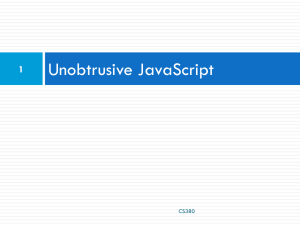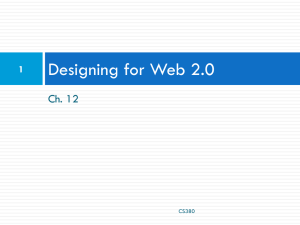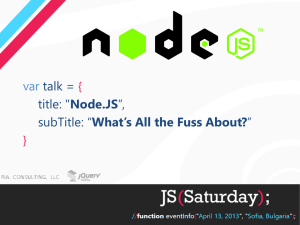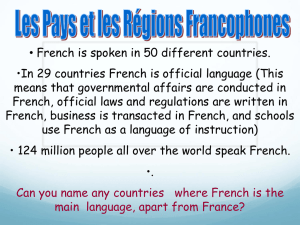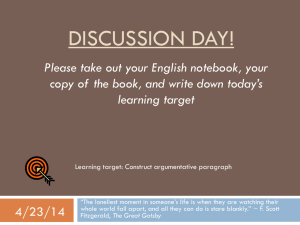DOM Tree: JavaScript & Prototype Presentation
advertisement
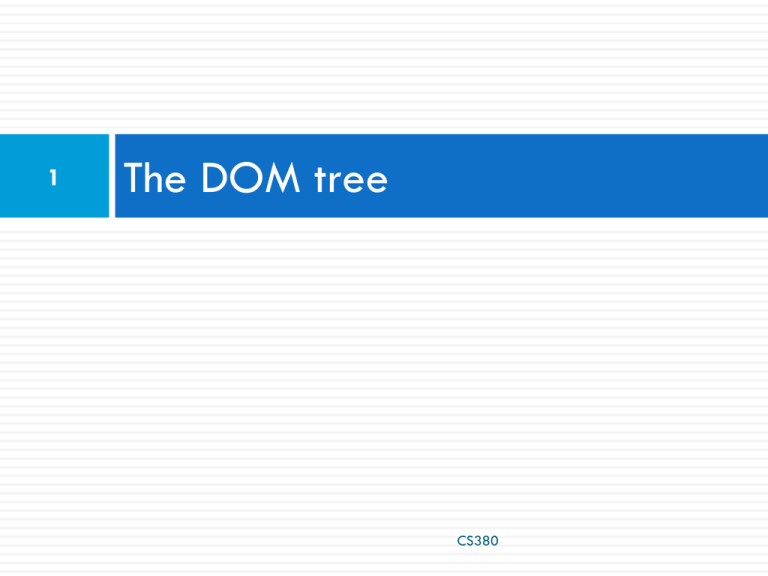
1
The DOM tree
CS380
The DOM tree
2
CS380
Types of DOM nodes
3
<p>
This is a paragraph of text with a
<a href="/path/page.html">link in it</a>.
</p>
element nodes (HTML tag)
can
have children and/or attributes
text nodes (text in a block element)
attribute nodes (attribute/value pair)
text/attributes
are children in an element node
cannot have children or attributes
not usually shown when drawing the DOM tree
CS380
HTML
Types of DOM nodes
4
<p>
This is a paragraph of text with a
<a href="/path/page.html">link in it</a>.
</p>
CS380
HTML
Traversing the DOM tree
5
name(s)
description
firstChild, lastChild
start/end of this node's list of
children
childNodes
array of all this node's children
nextSibling, previousSibling
neighboring nodes with the same
parent
parentNode
the element that contains this
node
•complete list of DOM node properties
•browser incompatiblity information
CS380
DOM tree traversal example
6
<p id="foo">This is a paragraph of text with a
<a href="/path/to/another/page.html">link</a>.</p>
HTML
CS380
Elements vs text nodes
7
<div>
<p>
This is a paragraph of text with a
<a href="page.html">link</a>.
</p>
</div>
HTML
Q: How many children does the div above have?
A: 3
an
element node representing the <p>
two text nodes representing "\n\t" (before/after the
paragraph)
Q: How many children does the paragraph have?
The a tag?
Prototype's DOM element methods
8
absolutize
addClassName
classNames
cumulativeOffse cumulativeScroll
empty
t
Offset
cleanWhitespac
clonePosition
e
extend
firstDescendant
getDimensions
getHeight
getOffsetParent getStyle
getWidth
hasClassName
hide
identify
insert
inspect
makeClipping
makePositioned
match
positionedOffse
readAttribute
t
recursivelyColle
relativize
ct
remove
removeClassNa
replace
me
scrollTo
select
setOpacity
setStyle
show
toggle
toggleClassNa
me
undoClipping
undoPositioned
update
viewportOffset
visible
wrap
writeAttribute
9
Prototype's DOM tree traversal
methods
method(s)
ancestors, up
childElements, descendants,
down
siblings, next, nextSiblings,
previous, previousSiblings,
adjacent
CS380
description
elements above this one
elements below this one (not
text nodes)
elements with same parent
as this one (not text nodes)
10
Prototype's DOM tree traversal
methods
// alter siblings of "main" that do not contain "Sun"
var sibs = $("main").siblings();
for (var i = 0; i < sibs.length; i++) {
if (sibs[i].innerHTML.indexOf("Sun") < 0) {
sibs[i].innerHTML += " Sunshine";
}
}
JS
CS380
Selecting groups of DOM objects
11
methods in document and other DOM objects for
accessing descendants:
name
description
getElementsByTagName
returns array of descendents
with the given tag, such as "div"
getElementsByName
returns array of descendants
with the given name attribute
(mostly useful for accessing
form controls)
CS380
12
Getting all elements of a certain
type
var allParas = document.getElementsByTagName("p");
for (var i = 0; i < allParas.length; i++) {
allParas[i].style.backgroundColor = "yellow";
}
JS
<body>
<p>This is the first paragraph</p>
<p>This is the second paragraph</p>
<p>You get the idea...</p>
</body>
CS380
HTML
Combining with getElementById
13
var addrParas = $("address").getElementsByTagName("p");
for (var i = 0; i < addrParas.length; i++) {
addrParas[i].style.backgroundColor = "yellow";
}
JS
<p>This won't be returned!</p>
<div id="address">
<p>1234 Street</p>
<p>Atlanta, GA</p>
</div>
CS380
HTML
14
Prototype's methods for selecting
elements
var gameButtons = $("game").select("button.control");
for (var i = 0; i < gameButtons.length; i++) {
gameButtons[i].style.color = "yellow";
}
JS
Prototype adds methods to the document object
(and all DOM element objects) for selecting groups of elements:
getElementsByClassName
array of elements that use given class
attribute
select
array of descendants that match given
CSS selector, such as "div#sidebar
ul.news > li"
CS380
15
Prototype's methods for selecting
elements
<ul id="fruits">
<li id="apples">apples
<ul>
<li id="golden-delicious">Golden Delicious</li>
<li id="mutsu" class="yummy">Mutsu</li>
<li id="mcintosh" class="yummy">McIntosh</li>
<li id="ida-red">Ida Red</li>
</ul>
</li>
<li id="exotic" class="yummy">exotic fruits
<ul>
<li id="kiwi">kiwi</li>
<li id="granadilla">granadilla</li>
</ul>
</li>
</ul>HTML
$('fruits').getElementsByClassName('yummy');
// -> [li#mutsu, …]
$('exotic').getElementsByClassName('yummy');
// ->
CS380
JS
16
Prototype's methods for selecting
elements
<ul id="fruits">
<li id="apples">
<h3 title="yummy!">Apples</h3>
<ul id="list-of-apples">
<li id="golden-delicious" title="yummy!" >Golden
Delicious</li>
<li id="mutsu" title="yummy!">Mutsu</li>
<li id="mcintosh">McIntosh</li>
<li id="ida-red">Ida Red</li>
</ul>
<p id="saying">An apple a day keeps the doctor
away.</p>
</li>
</ul>
$('apples').select('[title="yummy!"]');
// -> [h3, li#golden-delicious, li#mutsu]
$('apples').select( 'p#saying', 'li[title="yummy!"]');
//
$('apples').select('[title="disgusting!"]');
//
JS
CS380
The $$ function
17
var arrayName = $$("CSS selector");
JS
// hide all "announcement" paragraphs in the "news"
//section
var paragraphs = $$("div#news p.announcement");
for (var i = 0; i < paragraphs.length; i++) {
paragraphs[i].hide();
}
JS
$$ returns an array of DOM elements that match
the given CSS selector
like
$ but returns an array instead of a single DOM
object
a shorthand for document.select
useful for applying an operation each one of a set
of elements
Common issues with $$
18
// get all buttons with a class of "control"
var gameButtons = $$("control");
var gameButtons = $$(".control");
JS
// set all buttons with a class of "control" to have red
text
$$(".control").style.color = "red";
var gameButtons = $$(".control");
for (var I = 0; i < gameButtons.length; i++) {
gameButtons[i].style.color = "red";
}
JS
Q: Can I still select a group of elements using $$ even if my CSS
file doesn't have any style rule for that same group? (A: Yes!)
Creating new nodes
19
name
description
document.createElement("tag")
creates and returns a new empty
DOM node representing an element
of that type
document.createTextNode("text")
creates and returns a text node
containing given text
// create a new <h2> node
var newHeading = document.createElement("h2");
newHeading.innerHTML = "This is a heading";
newHeading.style.color = "green";
JS
merely creating a node does not add it to the page
you must add the new node as a child of an existing
element on the page...
Modifying the DOM tree
20
name
description
appendChild(node)
places given node at end of this
node's child list
insertBefore(new, old)
places the given new node in this
node's child list just before old child
removeChild(node)
removes given node from this node's
child list
replaceChild(new, old)
replaces given child with new node
var p = document.createElement("p");
p.innerHTML = "A paragraph!";
$("main").appendChild(p);
JS
CS380
Removing a node from the page
21
function slideClick() {
var bullets = document.getElementsByTagName("li");
for (var i = 0; i < bullets.length; i++) {
if (bullets[i].innerHTML.indexOf("children")
>= 0) {
bullets[i].remove();
}
}
}
JS
each DOM object has a removeChild method to
remove its children from the page
Prototype adds a remove method for a node to
remove itself
CS380
DOM versus innerHTML hacking
22
Why not just code the previous example this way?
function slideClick() {
$("thisslide").innerHTML += "<p>A paragraph!</p>";
}
JS
Imagine that the new node is more complex:
ugly: bad style on many levels (e.g. JS code embedded
within HTML)
error-prone: must carefully distinguish " and '
can only add at beginning or end, not in middle of child list
function slideClick() {
this.innerHTML += "<p style='color: red; " +
"margin-left: 50px;' " +
"onclick='myOnClick();'>" +
"A paragraph!</p>";
}
JS
23
Problems with reading/changing
styles
window.onload = function() {
$("clickme").onclick = biggerFont;
};
function biggerFont() {
var size = parseInt($("clickme").style.fontSize);
size += 4;
$("clickMe").style.fontSize = size + "pt";
}
JS
style property lets you set any CSS style for an
element
problem: you cannot (usually) read existing styles with
it
CS380
Accessing styles in Prototype
24
function biggerFont() {
// turn text yellow and make it bigger
var size = parseInt($("clickme").getStyle("fontsize"));
$("clickme").style.fontSize = (size + 4) + "pt";
}
JS
getStyle function added to DOM object allows
accessing existing styles
addClassName, removeClassName, hasClassName
manipulate CSS classes
CS380
25
Common bug: incorrect usage of
existing styles
this.style.top = this.getStyle("top") + 100 + "px";
// bad!
JS
the above example computes e.g. "200px" + 100 +
"px" , which would evaluate to "200px100px"
a corrected version:
this.style.top = parseInt(this.getStyle("top")) + 100 +
"px"; // correct
JS
CS380
Setting CSS classes in Prototype
26
function highlightField() {
// turn text yellow and make it bigger
if (!$("text").hasClassName("invalid")) {
$("text").addClassName("highlight");
}
}
JS
addClassName, removeClassName, hasClassName
manipulate CSS classes
similar to existing className DOM property, but
don't have to manually split by spaces
CS380
Example: createElements
27
<html>
<head>
<script src="
https://ajax.googleapis.com/ajax/libs/prototype/1.7.0.0/pr
ototype.js " type="text/javascript"></script>
<script src="paragraph.js "
type="text/javascript"></script>
</head>
<body>
<div id="paragrapharea">
<button id="add">Add a paragraph</button>
</div>
</body>
</html>
CS380
Example: createElements
28
window.onload = function(){
var button = $("add");
button.onclick = addParagraphClick;
}
function addParagraphClick(){
var paragraph = document.createElement("p");
paragraph.innerHTML = "All work and no play makes
Jack a dull boy";
var area = $("paragrapharea");
area.appendChild(paragraph);
}
function addListClick(){
}
CS380
JS
Javascript Exercises
29
Create a webpage with an of Homer Simpson
image at the center of the page. Develop a script
that prints an alert: “Duh, you are hovering!!” every
time the mouse crosses over the image.
Add 5 buttons to your webpage: red, yellow, green,
black, and silver. Every time you click on one of
these buttons the background should take the
corresponding color.
CS380
Javascript Exercises
30
Add a link with the text: “CLICK ME!”. Develop a
function that randomly chooses between the
following websites to link your text:
http://slashdot.org/
http://www.thinkgeek.com/
http://despair.com/
http://www.redbubble.com/
http://googleresearch.blogspot.com/
CS380


